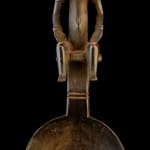Senufo Wooden Ceremonial Spoon, 20th Century CE
Wood
33.7 x 11.7 cm
13 1/4 x 4 5/8 in
13 1/4 x 4 5/8 in
CK.0059
Further images
The Senufo are one of West Africa’s most important groups, and also one of the most productive in terms of artistic output. There are roughly 1.5 million Senufo people, living...
The Senufo are one of West Africa’s most important groups, and also one of the most productive in terms of artistic output. There are roughly 1.5 million Senufo people, living across the Ivory Coast, Mali and Burkina Faso. Senufo society is governed by a council of elders and the Poro society. The Senufo are perhaps best known for their artworks, which reflect their complex social structures and belief system. Secular objects such as beds, stools, chairs, heddle pulleys and canes are all decorated with Senufo iconography, while metal pieces are used as amulets, and for apotropaic functions. The Poro society commissions many masks for ceremonies including dances, initiations and funerals/crises. Sculptures are also known, ranging from miniatures up to life-size anthropomorphic pieces. The most famous variant is the pombilele, elongated figures with solid bases which have become known as rhythm pounders. When not being used to keep the rhythm for dancing, they were stood in the Poro society’s sacred enclosures; their other task was to tamp down the earth atop the graves of prominent Poro members, to ensure that the spirit of the dead is directed to the afterlife rather than returning to haunt the living.
This wooden spoon features a handle that has been carved in the form of a seated woman. Her facial features are characteristic of the Senufo style, including her almond-shaped eyed, long thin nose, and small pursed lips. A series of diagonal parallel lines decorate her cheeks, no doubt symbolizing scarification patterns found among the Senufo. Other scarification markings, such as the lines surrounding her navel in a cruciform pattern are also typical. In real life, scars such as these were considered marks of beauty and rank. Her high ranking status is further suggested by the bracelets and armbands she wears, as well as the mere fact she is seated upon a stool, equivalent to being seated upon a throne in Western cultures. A spoon such as this one was not a household, everyday item. Instead, it would have been used exclusively for ceremonial purposes, possibly related to wedding festivities of coming-of-age rituals.
This wooden spoon features a handle that has been carved in the form of a seated woman. Her facial features are characteristic of the Senufo style, including her almond-shaped eyed, long thin nose, and small pursed lips. A series of diagonal parallel lines decorate her cheeks, no doubt symbolizing scarification patterns found among the Senufo. Other scarification markings, such as the lines surrounding her navel in a cruciform pattern are also typical. In real life, scars such as these were considered marks of beauty and rank. Her high ranking status is further suggested by the bracelets and armbands she wears, as well as the mere fact she is seated upon a stool, equivalent to being seated upon a throne in Western cultures. A spoon such as this one was not a household, everyday item. Instead, it would have been used exclusively for ceremonial purposes, possibly related to wedding festivities of coming-of-age rituals.







